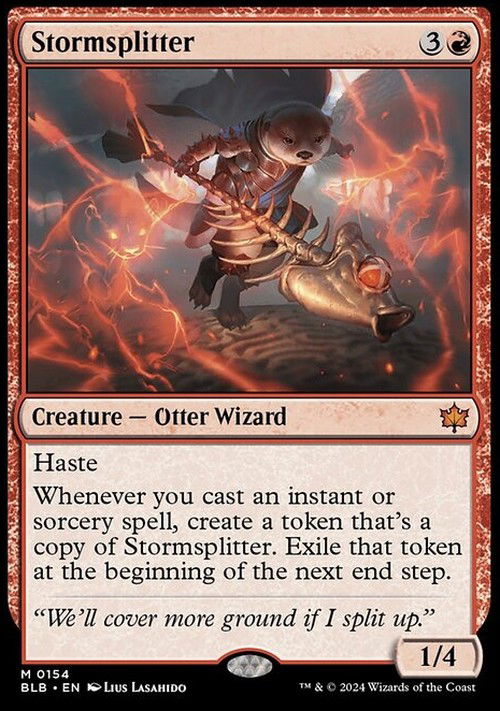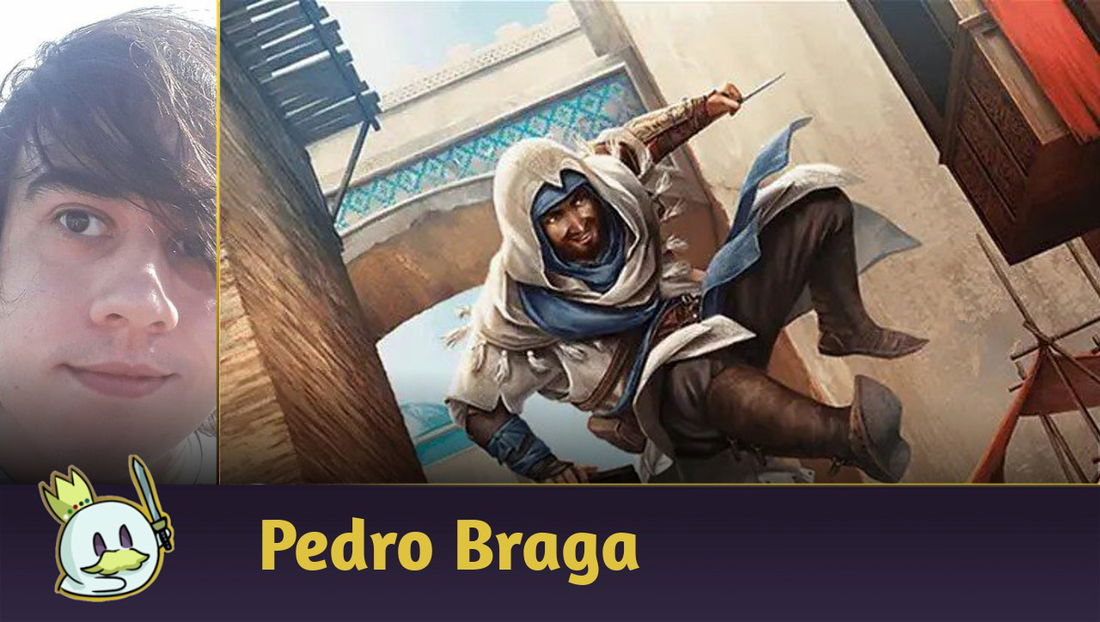The preview season for Bloomburrow continues in full swing, and the expansion's choices of unusual creature types have brought a lot of speculation about the competitive impact they could have in formats when together in the same deck.
A new otter, however, has given players something to talk about because its abilities simulate one of the most broken mechanics in the game's history: Storm, with Stormsplitter, whose ability copies it whenever its controller casts an instant or sorcery spell.
Ad
With the potential to shape new archetypes, could the creature be one of the sets most impactful cards for the competitive scene, or just another one of the famous cards that generate a lot of hype, but few practical results?
Stormsplitter - Review

Stormsplitter is a strange creature to evaluate because it is in a middle ground between Empty the Warrens and Young Pyromancer: on the one hand, it doesn't work in the same sequence as Storm spells because you need to start sequencing after putting it into play, so the famous combination of Rituals and cantrips/tutors to get to the card doesn't make much sense.
On the other hand, the new creature requires a shorter sequence of spells to reach lethal damage: each instant or sorcery you cast will create a copy of it, and each copy also creates copies with the next spell - that is, to reach lethal damage, you need five instants or sorceries after Stormsplitter comes into play (the first creates one copy, the second creates two, the third creates four, the fourth creates eight, the fifth creates 16), and can finish the game up to one turn after it is cast.
The greatest challenge, obviously, is creating a consistent shell for finding the creature and then protecting it from removal to sequence our spells, as well as needing to use them after casting it, which can be counterintuitive with the way how Storm decks are often constructed.
In the case of removals, Stormsplitter offers a strategic advantage if the game goes on for too long: its copies last until the beginning of the next End Step - so its controller can “protect” it from removals by using spells to copy it, and when we reach the end step, with the trigger on the stack, use another spell to create another copy, which will last until the opponent's end step, where we can use another spell to create another copy and untap with it to close the combo.
The new otter is also easy to get out of control, making it an excellent card to build around, especially in formats in which the Storm mechanic doesn't exist, where it can give combo fans a new proposal for Standard and Pioneer.
Stormsplitter on Standard
Standard loses some cheap cantrips with the rotation: Consider, Ancestral Anger are the main ones that leave the Metagame, but other options like Sleight of Hand, Timely Interference and Take the Fall remain and can serve as a cheap means of drawing cards and sequencing spells alongside the recently revealed Might of the Meek - as well as complementing Poison's well-known game plan with Venerated Rotpriest.

Between Shore Up, Royal Treatment, Surge of Salvation and Tyvar's Stand, the deck also doesn't lack good protections to interact with the opponent at the time of the combo, in addition to being one-mana spells to help with the sequencing.
Ad

Honestly, the current circumstances don't seem to favor Stormsplitter as a creature capable of breaking Standard, but other proposals less focused on an “all-in” combo place the creature in a dangerous space, where a few removals and cantrips are enough to transform it at a risk at the board and must-answer threat, and a difficult one to interact with as the game extends.
Stormsplitter on Pioneer
Pioneer, on the other hand, has a dozen cheap spells to be used alongside Stormsplitter and a few shells where the creature could fit: Consider, Opt and Treasure Cruise come together with other options to sequence the number of spells needed per turn, as well as a combo mentioned on Twitter with Jeskai Ascendancy and Cryptolith Rite (of which, honestly, both seem very win more ).

The problem is that a deck with this combination is essentially trying to do the same thing as Izzet Phoenix, but with less consistency. And in Izzet Phoenix itself, perhaps Stormsplitter finds space in the Sideboard as a card that allows us to “free-win” in games where our clock needs to be faster, while we play around graveyard hate, since four mana isn't an impossible cost for the list, and we can use our Instant-Speed cantrips to “hold” copies in the opponent's End Step.

Pioneer also has an easier time finding the creature with cards like Dig Through Time, and perhaps even Lotus Field could be interested in a copy of it as another way to win the game, but it seems less efficient than Approach of the Second Sun or Zacama, Primal Calamity in that sense.
Stormsplitter on Modern
As the only format among those mentioned where Storm spells actually exist, Stormsplitter competes for space in Modern with Empty the Warrens and, to some extent, Grapeshot - and here, it is necessary to consider the change of proposal that the card demands with the current archetype.

Stormsplitter requires casting it before starting the sequencing and four mana is a bit of a high cost to “do nothing” and not be a payoff for Desperate Ritual and Pyretic Ritual, and while the Ruby Medallion cost reduction certainly makes a difference for the card, the number of steps for it doesn't differ that much from other spells while it demands greater risks.

Perhaps, Wish in Ruby Storm could even give a slot in the Sideboard to find Stormsplitter and have a new attack angle, but would it be so different from looking for a Empty the Warrens to the point of being worth the slot?
With a Ruby Medallion or Ral, Monsoon Mage in play, sequencing Pyretic Ritual to Wish to Stormsplitter already requires as much investment in spells and mana than Empty the Warrens - a total of eight spells to put 16 copies into play (one ritual for Wish, one ritual for the creature, five other spells), the same amount as Empty the Warrens requires to put the same number of Goblins into play while it can be resorted to with Past in Flames.
Ad
Therefore, while its proposal is interesting, Stormsplitter doesn't compete well with Storm itself and, therefore, should stay away from formats where Grapeshot and Empty the Warrens are legal.
Conclusion
That's all for today!
If you have any questions or suggestions, feel free to leave a comment!
Thanks for reading!








— Comentarios0
Se el primero en comentar